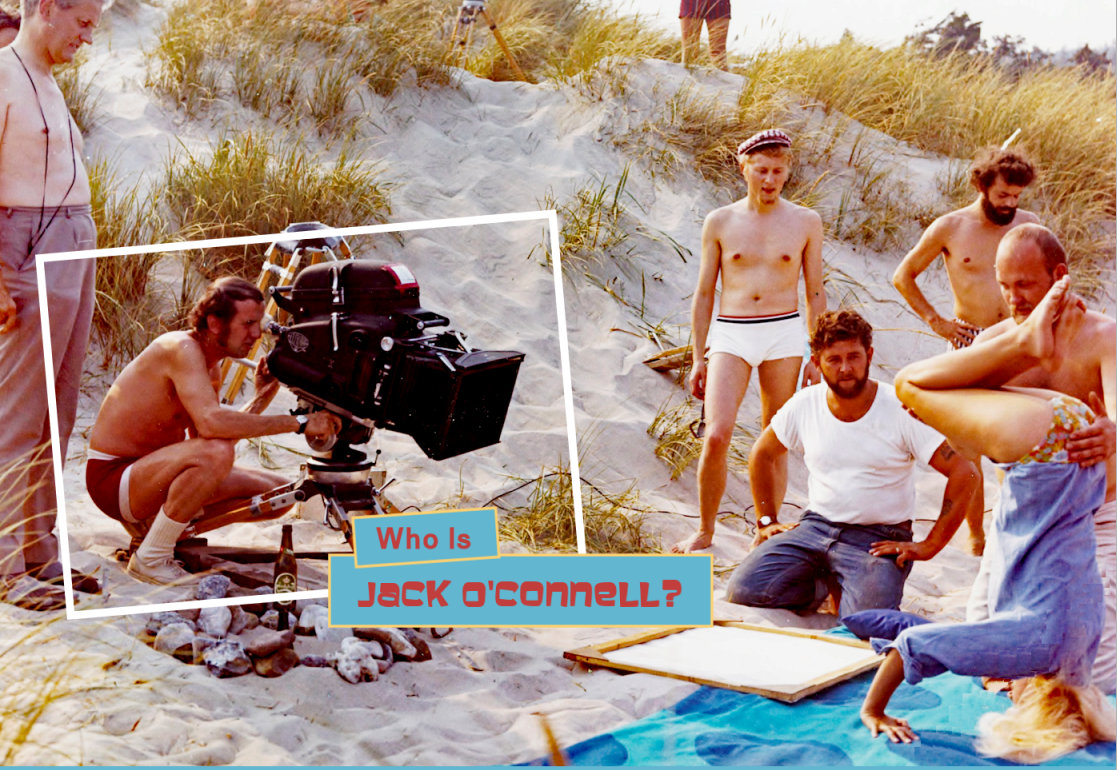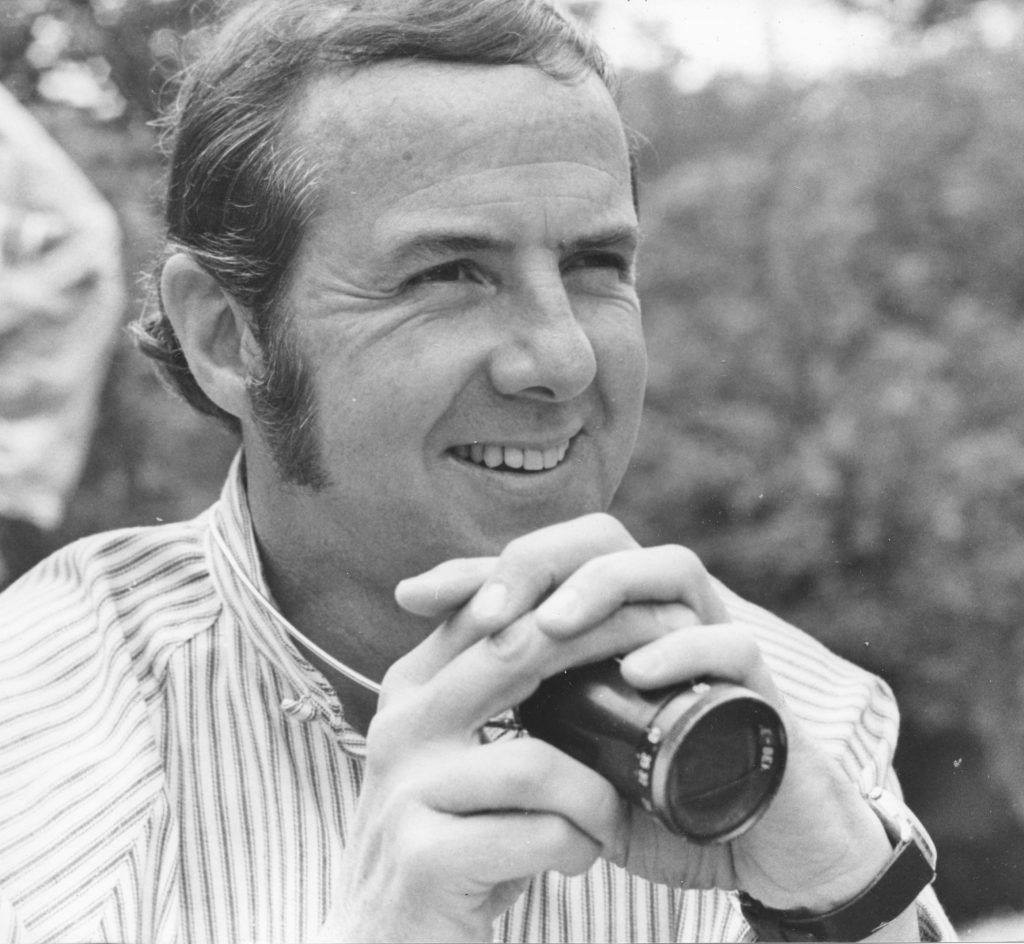
Jack O’Connell, 1962
MEET JACK O'CONNELL
Writer, Director, 60s Icon
Jack O’Connell, an overlooked pioneer of independent cinema, captured the zeitgeist of 60s America with Revolution, his iconic documentary of the San Francisco hippie counter-culture during the Summer of Love, 1967.
Revolution Trailer
Jack O’Connell’s Biography
Jack spent 10 years in advertising as a Mad Man (as in “Mad Men”), and in 1959 traveled to Italy to learn filmmaking with Fellini (on La Dolce Vita) and Antonioni (L’Avventura).
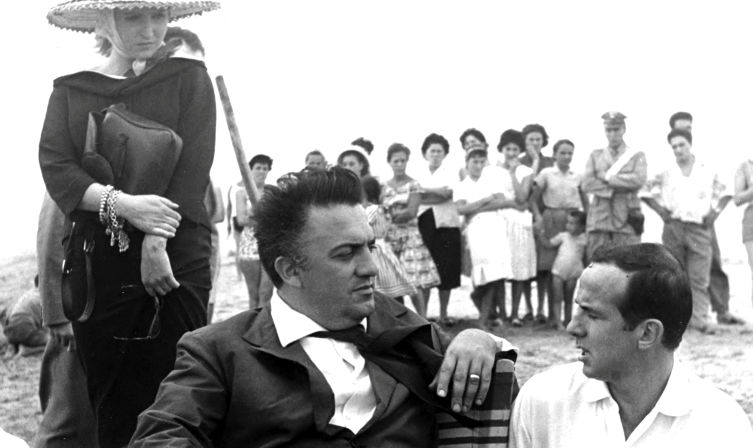
Fellini (left) and Jack on the set of La Dolce Vita
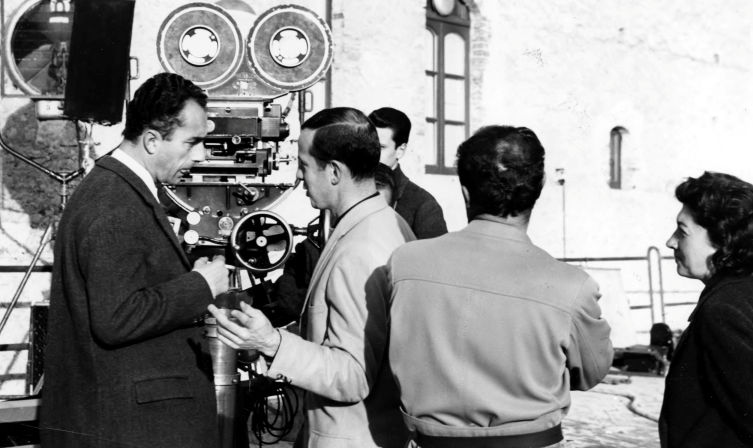
Antonioni (left) and Jack on the set of L’Avventura
The Hippie Revolution
In 1986 Jack turned back to San Francisco to renew his acquaintance of the beautiful hippie chick, Today Malone, from his original footage. He filmed her again, ingeniously incorporating the new material with the old. He called this updated Revolution, The Hippie Revolution.
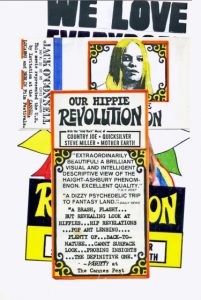
The Hippie Revolution was invited to the Second Leningrad International Documentary Festival in January 1991 when the USSR was falling apart. The film was screened at a cinema in the city to a large, enthusiastic audience and in the main festival competition hall after the closing ceremonies.
For an account of this eye-opening visit to Russia (when old Soviets were crying out for a return to Stalinism), read The Matryoshka Murders, a thriller by Kay Williams, Jack’s longtime assistant, who traveled with him to Leningrad.
The Matryoshka Murders opens in 1991 at the Leningrad Documentary Festival, where Kate and Dominick have been invited to show their film Revolution. Kate videotapes stories of real Russian people for her NYC guerrilla film class and finds herself in the crosshairs of the KGB.
Other Films
Jack’s first film, shot in 1962, was Greenwich Village Story, set in the bars and beatnik coffee houses of the Village,
He wrote, produced, and directed two more films, Christa (aka Swedish Fly Girls, 1970) and City Women (formerly Up the Girls, 1974, never released), always remaining fiercely independent.
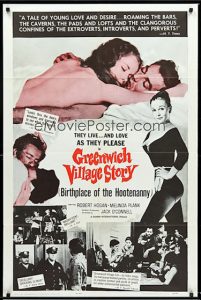
Greenwich Village Story
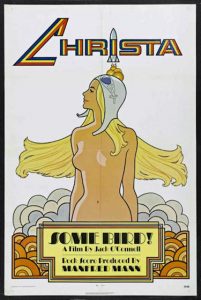
Christa (aka Swedish Fly Girls)
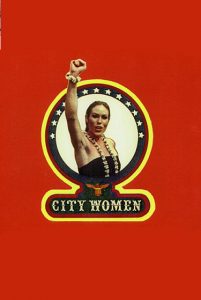
City Women (formerly Up the Girls)
INTERVIEW WITH JACK
Short award-winning film interview of Jack at age 88 ½ by Amy Helene Johansson
Commentary by Bruce Eder about Jack O’Connell’s Career
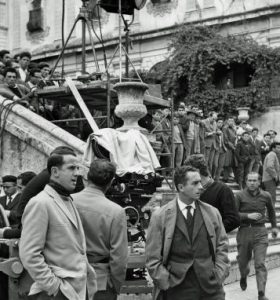
Jack (l) and Antonioni, L’Avventura
Filmmaker Jack O’Connell
— not to be confused with the similarly named actor of the 21st century — was one of the more interesting directorial figures to emerge from New York City in the 1960s. He began his professional life as an advertising man in the 1950s, a denizen of New York’s Madison Avenue; but he was bitten by the filmmaking bug and chucked that career to go to Italy, where he soon worked his way into the movie industry. O’Connell was fascinated by the neo-realist work of such figures as Vittorio de Sica, Roberto Rossellini, Michelangelo Antonioni, and Federico Fellini and it was through Antonioni that he received his first screen credit, as a special assistant to the director on L’Avventura (1960) (in which he also played a small on-screen role).
After returning to the United States, he made his directorial debut with the drama Greenwich Village Story. Strongly reminiscent of La bohème in its plot, the movie — shot entirely on location in Greenwich Village — was set amid a world of beats, poets, and NYU students, and amid an earnest (and beguiling) cast, led by Robert Hogan and Melinda Plank (aka, Melinda Cordell), one could spot future filmmakers James Frawley and John G. Avildsen as well as future television star Mel Stewart. The movie attracted some attention at the time and seemed to promise very good things from O’Connell, as did his next effort, the documentary Revolution (1968), shot among the hippies of San Francisco’s Haight-Ashbury and featuring the music of the Steve Miller Band, the Quicksilver Messenger Service, and Mother Earth. Alas, a dispute with the union representing projectionists in New York City hobbled the movie’s roll-out and, ironically enough, it was by the presence of the soundtrack LP in stores that most audiences ever knew of the film’s existence.
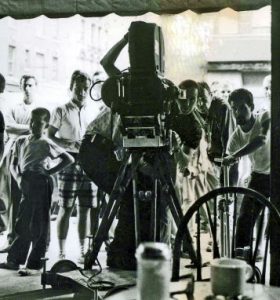
Jack behind camera, Greenwich Village Story
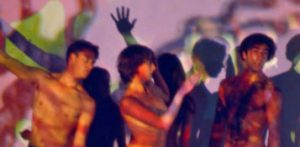
Ann Halprin dancers (from Revolution), Daria Halprin second from left
One person who did see the movie was Antonioni, who reportedly spotted Daria Halprin, a dancer who appeared in Revolution, whom the Italian director subsequently put into a co-starring role in his counter-culture drama Zabriskie Point (1970).
O’Connell’s third film, Christa (1971), was a huge success in America, mostly owing to its subject matter and marketing. Shot in Denmark, it told the story of a young, free-loving airline flight attendant who has abandoned her husband and child, and depicted her various erotic and emotional adventures.
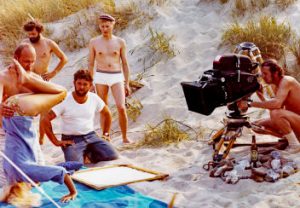
Jack (right, behind camera) and crew on beach in Denmark, Birte Tove (left),
standing on her head
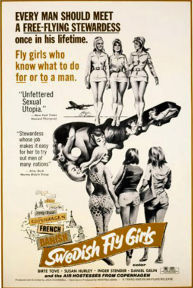
Distributed in America by American International Pictures, it was re-titled Swedish Fly Girls — Sweden somehow being a more marketable locale for American purveyors of erotica than Denmark — and it became a huge money-maker in its time.
In the years after, a series of personal and health difficulties thwarted O’Connell’s efforts at further filmmaking, and even his efforts in the 1990s at remarketing Revolution ran into unexpected complications, when the owners of the 1985 feature film Revolution (starring Al Pacino, et al) threatened legal action over the use of the title, so he had to reissue it as The Hippie Revolution. ~ Bruce Eder, Rovi
REVOLUTION
Directed by: Jack O’Connell
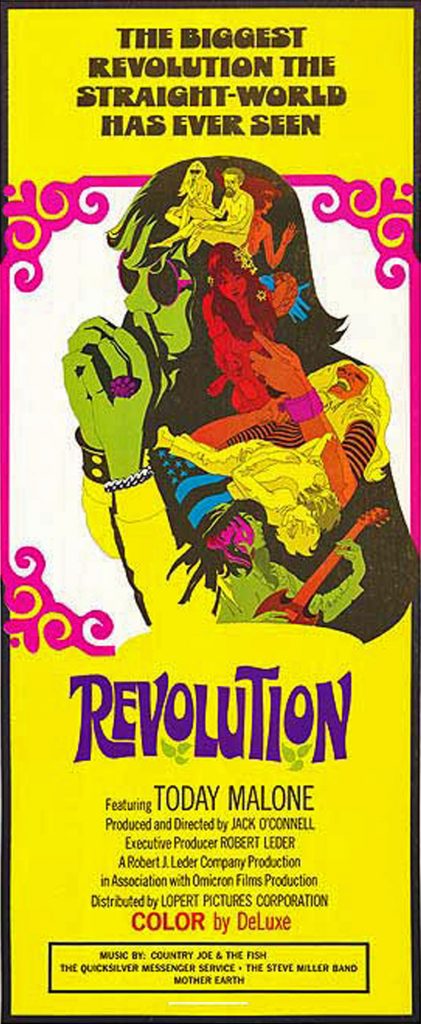
REVOLUTION, COLOR, 1968
Synopsis
The hippie spirit of Haight-Ashbury is alive and well in this rough-around-the-edges documentary, shot in the heart of San Francisco during the groovy days when hair was long, love was free and acid abounded. Featuring concert footage of Country Joe and the Fish and other bands, director Jack O’Connell’s quirky film captures the counterculture’s scope, from impassioned leaders such as Rev. Cecil Williams down to ordinary freaks on the street.
Viewer Reviews
Immensely enjoyable for a number of reasons. Before I mention them let me say I was Detroit’s first hippie, went back and forth from the Midwest to SF and LA and was in Frisco in 1965-66, part of 67. I had left the CITY by the time this film was made and had already considered the scene over. It was a time however when you could walk down the street and actually feel the vibe of the people you met. I know that sounds like bull but I was there and for a brief time it was real. The lightshow footage and the dance sequences are the real deal. Some of the people interviewed are able to clearly express the essence but most won’t understand any more than a description of the color blue. Loved the footage of Hippie Hill, but Haight had become a mini-ecological nightmare. Too many people for too few resources, hard drugs and prostitution appeared, kids sleeping in doorways. It didn’t take long for something beautiful to convert into something that was superficial and quickly commodified. Yes, to most it will seem trite and corny but the savage apes have two wars going and almost no protest. One of the reviews finds it irritating that the hippie chick was panhandling. You miss the point, money is needed to survive in this consumer based mess. Hippies just don’t worship it like the straights do. Peace on Earth. Goodwill to all beings. I’m still dropped out.
This is one of the best documentaries I’ve ever seen. It’s a well thought out film about and made by a bunch of hippies who like to drop acid all the time. Nothing more, nothing less.
I had a blast watching this, the fun never ended. I felt like I was there, and a part of it. I didn’t want it to end. I felt this film really got in the middle of what was happening in the heart of a hippie. The thing I like the most about it was that it was coming from mainly the youth, from their perspective. I also liked that it was mellow, it didn’t just show the youth talking, there were parts where music was just playing, dancing, being happy, and feeling all the love in the center of the universe; words weren’t needed to get the blissful vibe. Definitely in my top 10 favorites of all time.
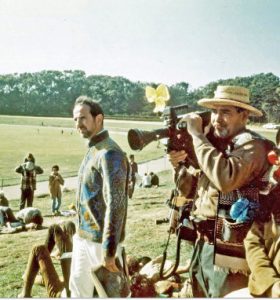
Jack (l), 1967, with camera crew, Golden Gate Park
Peace, love and groovy, mind-altering drugs are the topics at hand in this San Francisco freak-out documentary. It’s a crude but heartfelt time capsule, released in the summer of ’68, just before the Haight Ashbury scene turned into one big, unwashed bummer. And even if director Jack O’Connell (THE GREENWICH VILLAGE STORY, SWEDISH FLY GIRLS) may not have made a great movie, he was at the right time, at the right place, and (most important) with the right tripped-out attitude… Much of the movie is random footage of the hippie phenomenon, while a cute, blond, 20-year-old runaway named “Today Malone” provides a (slight) framework to this ragged mess. And a bigger bunch of long-haired, wide-eyed freaks I’ve never seen — crammed shoulder-to-shoulder, celebrating the summer solstice in the Golden Gate Park. God, the stench of patchouli must’ve been nauseating! Bands blast away, hippie chicks spin in circles, the lightshow begins, and it’s the same old acid haze we’ve come to know and love. Along the way, some interesting tidbits sneak in, including firsthand tales of getting busted, posted notes to runaway children, Ms. Malone unsuccessfully begging passers-by for spare change, a middle-aged nun describing how she’s similar to these “hippie girls,” and a typical hairball asked if he worries about chromosome damage from too much acid (when it’s, obviously, already too late).
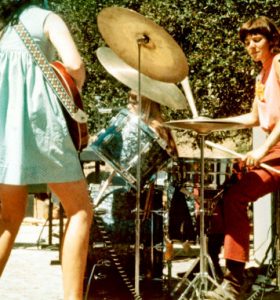
The Ace of Cups on Mt. Tam, 1967
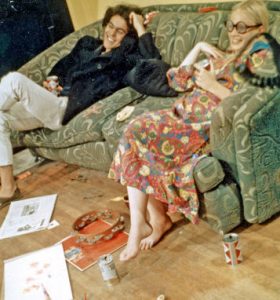
LSD Trip-with hippie chick “Today” Malone (right) and friends
Of course, what movie about drugs is complete without a few suited “experts” (including San Francisco’s Director of Public Health and the thick-necked Chief of Police) warning about the evils of this new generation’s chemical dependence. But in the long run, this is a refreshingly pro-drug, pro-hippie pic that pushes the joys of LSD when Today doses on camera, and flies off on its mind-altering effects (actually, all they do is sit around a room, rolling their eyes and feeling a peach). The filmmakers have all the bases covered. They document the oddest niches of Hippiedom, which appeals to the curious. There are plenty of groovy visuals, in case you’re dosed. They even toss in some nude performance art to suck in the T&A crowd. It also features ragamuffin fashion at its worst (not as ratty as today’s Squatter Chic look, but close), plus music by Country Joe and The Fish, Quicksilver Messenger Service, and The Steve Miller Band… Nowadays, this nonsense is impossible to watch without laughing at these naive, burnt-out rebels, and it’s a reality check for folks who think the hippie subculture was exactly like PSYCH-OUT or THE TRIP. Unfortunately, real life was a lot less charismatic than reel life. And whenever one of these wide-eyed innocents vows they’ll never conform to The System, I’ll give you odds that nowadays, they’re somewhere in suburbia, selling Amway products and falling asleep to AMERICA’S FUNNIEST HOME VIDEOS.
Revolution was invited to the Cannes Film Festival in 1968, but because of student riots against capitalism in France, political leaders there feared civil war or revolution. The film was withdrawn from the Cannes Festival because it was too incendiary for that time.
The Hippie Revolution (updated Revolution, 1986)

In 1967, free spirit Today Louise Malone hawked alternative papers on the streets of San Francisco
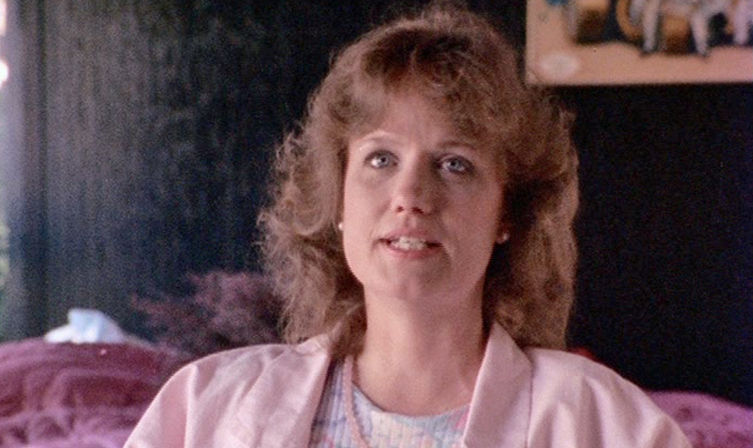
By 1986, Louise had become a nurse and a mother of two
A Revived 1968 Documentary Brings Back the Psychedelic Past
By Richard von Busack, Metro
WATCHING The Hippie Revolution in an almost-empty movie theater was a thrill. I felt that I was recreating Chuck Heston’s big scene from The Omega Man, where he sits in a theater bitterly watching Woodstock as the world goes to hell outside. Jack O’Connell’s 1968 documentary– newly revived and updated with some modern reminiscences–details the Summer of Love in 1967, without chronology or identification of the participants.
The accompanying music is by Steve Miller, Quicksilver Messenger Service and Country Joe and the Fish. One distinctive part of psychedelic music, which I love sincerely, is the prevalence of apparently three-fingered keyboardists; in such a milieu, the Doors’ Ray Manzarek was considered as facile as Glenn Gould.
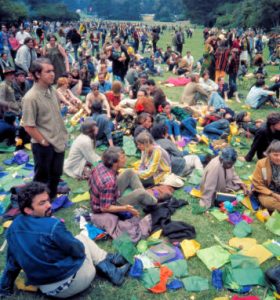
Golden Gate Park, 1967
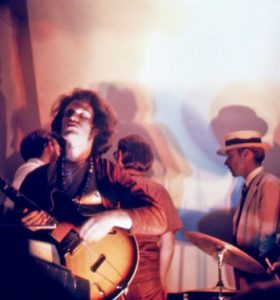
Light Show Musicians
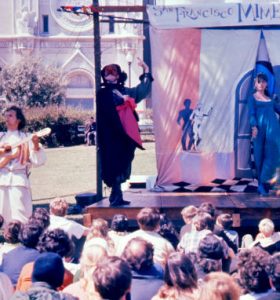
Mime Troupe
The interviews mostly immobilize the film. Despite the hippies’ laudable aims, they were not great conversationalists. The refusal to identify the talking heads may be a way of showing solidarity with the girl who says she thinks astrological signs might be more important than names. Nevertheless, one can pick out Frank Jordan, Cecil Williams and Herb Caen, who claims to have been smoking grass ever since he was a police reporter in Sacramento. The main interviewee, however, is typical dropout Louise Malone, nicknamed “Today.”
Far more interesting than the interviews is the scene in which O’Connell’s camera races around a roomful of trippers–and one dozing tabby–to sum up the fleeting moods of an LSD trip. The more conventional images of psychedelia show up as well: the treated film stock, the light shows and the naked girl bouncing through the daisies (the “Where’s Waldo” of these hippie documentaries).
All the talk of a unified front and love power notwithstanding, it’s obvious which way the interviewees are going to head. A Mime Troupe member forecasts, with his smugness, 30 more years of the group’s self-righteousness. It is also easy to predict who’s going to fall apart from too much brain candy, and who is, depending on your point of view, going to buy in or sell out. As a musician worries, “Are we going to turn them on, or are they going to turn us off?”
It was the latter, of course. The hippies’ efforts may not have been lasting; they were fuzzy thinkers who produced little art that endured. Today, “Today” is a nice single mom with two kids, a house and a swimming pool in New Mexico. Other people, who didn’t end the game with those prizes, have wondered aloud if it was all worth the effort.
Yet, to imagine an America in which the hippies didn’t materialize is to imagine It’s a Wonderful Life’s Pottersville with more guns and police, a place in which the vision the hippies once supplied didn’t counter the triumph of repression and conformity. O’Connell’s documentary doesn’t suggest this, but he had the presence of mind just to let the camera run and capture the endless parade down Haight Street in 1967. It is in these scenes that the pricelessness of The Hippie Revolution is revealed. The Hippie Revolution (Unrated; 93 min.), a documentary by Jack O’Connell.
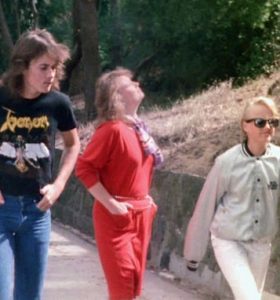
Today (center) with son Demian and daughter Melody, 1986
The Hippie Revolution
WATCH the Entire Movie
GREENWICH VILLAGE STORY
Directed by: Jack O’Connell
GREENWICH VILLAGE STORY, B&W, 1963
Synopsis
Brian, an award-winning writer who is working to complete his first novel, lives in Greenwich Village with Genie, a ballet dancer waiting for a break. Despite financial difficulties, they are happy members of the bohemian community, sharing in the hope that they will find themselves through honest self-expression. Genie hopes that they will marry; when she becomes pregnant she tries to persuade Brian without revealing her condition. He tells her that he will marry her if his novel is accepted; instead the book is greeted as immature and pretentious. Anne, a wealthy admirer, persuades Brian to join her for a weekend at her father’s estate. Genie, afraid that she is losing him, visits an illegal abortionist. Brian returns home filled with remorse, but it is too late: Genie dies as a result of the operation and Brian is left heartbroken. Interesting scenes shot in Greenwich Village, early sixties, beatnik poets in coffee houses.
Greenwich Village Story, released in 1963, launched several successful careers.
- John Avildsen was the Assistant Director of the film and also played Alvie, the artist in Washington Square Park. He later directed many movies, including JOE, THE KARATE KID, ROCKY and won an Oscar for direction of SAVE THE TIGER.
- James Frawley, who played Norman, went on to direct several films, including THE MUPPET MOVIE, which was nominated for two Oscars.
- James Cresson played George, the young advertising executive. He later became co-producer of the original Broadway productions of TWENTIETH CENTURY and CHICAGO.
- Mel Stewart became Carroll O’Connor’s first black neighbor and friend in ALL IN THE FAMILY. Since then Mel has been an actor in several TV series.
- Paul (Noel) Stookey, before he became part of the famous trio, Peter, Paul and Mary, was the performer at the Gaslight.
Greenwich Village Story represented the U.S. by invitation at the Venice Film Festival along with HUD (starring Paul Newman). It then played in theaters in 207 U.S. cities and in the U.K., Australia and Germany (dubbed into German for TV, decades ago).
- 1988 – it was part of Film Forum’s two-week program about the Beats and Beatniks.
- 1989 – the film played at the Cleveland Cinematique
- 1990 – invited to be part of NYU’s Department of Performance Studies
- 1996 – had three showings at the Whitney Museum finale of their 3-month program about the BEAT CULTURE and The New America
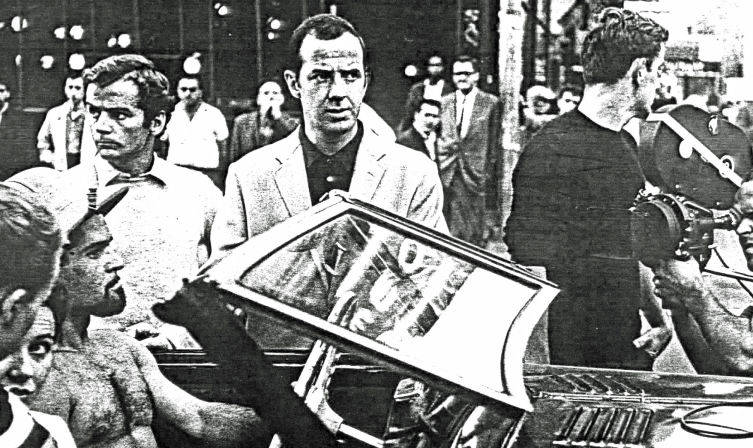
Shooting Greenwich Village Story in 1962, John Avildsen, Asst. Dir. (left) and Jack
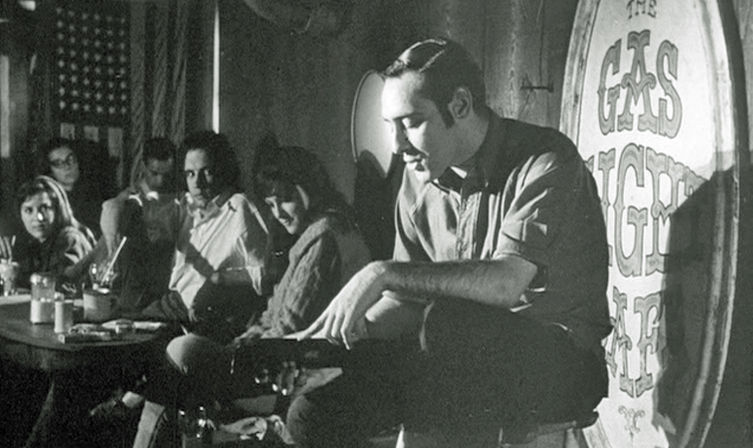
Beat poet reads in Gaslight Café, 1962, still from Greenwich Village Story
GREENWICH VILLAGE STORY
WATCH the Entire Movie
CHRISTA (aka SWEDISH FLY GIRLS)
Produced, written and directed by Jack O’Connell
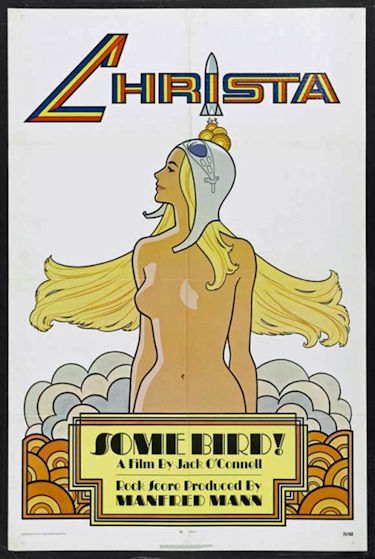
CHRISTA (AKA SWEDISH FLY GIRLS) 1970, Distributed by AIP
A brief intro, originally written by Kell. (You can see the reprint of the original press cutting of this review in Fiddlestix Magazine #38,):
Christa (U.S.-Danish-Color), Cannes, May 15, 1971 Astron (New York) release of Astron & Laterna Film (Denmark) coproduction.
Produced, written and directed by Jack O’Connell. Stars Birthe Tove, Daniel Galin, Baard Owe, Clinton Greyn, Ciro Elias. Camera (Eastmancolor) Henning Kristiansen. Editor, Russell Lloyd. Musical score, lyrics and playing, Manfred Mann.
Reviewed at Cinema Le Star, Cannes, May 14,’71. Running Time: 94 MINS.
Synopsis
Jack O’Connell spent the summer of 1969 in Denmark. His San Francisco feature, Revolution, fared well at the Danish box office. The Scandinavian easygoing manners, the freshly-green landscapes and the particular cool-yet-hot appeal of haute couture model Birthe Tove tempted O’Connell to make a film there and then. He approached Laterna Film’s open-minded Mogens Skot-Hansen, a production team was set up, the film was shot; then nothing was heard or seen about it till fest time Cannes 1971 with Christa posters everywhere.
Reportedly O’Connell’s film had an original running time of close to four hours. The editing job went from one to another until it was beautifully handled by Russell Lloyd. Al Kooper did a musical score for the film but various artistic and financial trouble seems to have arisen and Manfred Mann came around with lyrics and another score with more relevance to the story line.
The woman of the title is an airline stewardess in some rather futuristic company. She does all the things airline stewardess normally never do: she flirts brashly with male passengers and gives them lifts from the airport in Kastrup to her Copenhagen home where she beds down with them. The sex scenes are mostly tributes to Miss Tove’s spectacular body. The males involved are generally seen as rather stunned spectators as they might well be.
Christa, it appears, has a son by a former, short-lived affair with a young businessman (Baard Owe), but the son is kept at some rural outpost with Christa’s parents. Between lovers, Christa has embarrassing confrontations with her child’s father who is hell bent on trouble and, to prove his absolute impotence in handling the conditions of life, suicide.
Not all Christa’s lovers become real lovers. For instance, Daniel Gelin frowns philosophically and insists that music (he is a symphony conductor) demands his life juices.
All the way, the film is beautiful in its visual aspects. Camera chief is Henning Kristansen but a cameraman does not, however, make a film.
Birthe Tove is a joy, a natural-born actress who has been used in other current Danish productions, such as Gabriel Axel’s Harlequin’s Stick and John Hilbard’s Bottoms Up. Nudity may have been her main attractions so far, but O’Connell also brings forth an inner beauty that compares favorably with her physical look-alike, Catherine Deneuve.
Swedish Flygirls (aka Christa)
WATCH the Entire Movie
CITY WOMEN (formerly UP THE GIRLS)
Directed by Jack O’Connell
CITY WOMEN (formerly UP THE GIRLS), color, 1975
Based on the play, Tales of Women by Max G. Weine
Synopsis
The film is a comedy set in New York City about four women, each a writer, and their publisher. He is trying to get out a book called Tales of Women and have each contribute her own life story. Carrie, age 32, is Ms. Super Women’s lib. She wants her work published in hardcover, not paperback—and certainly not part of a collection. And exactly the way she wrote it without the meddling of any editors. Enid is a 22-year-old topless dancer. She has a let-it-all-hang-out personality, and that’s the kind of story she’s writing about her life. Third is Pauline Swift, 30, black and already “Number Two” in the publicity department of a big advertising agency. She’s very interested in becoming a celebrity and has a wide circle of amours. The fourth is Christine, 26, divorced. She was married for several years in Columbus, Ohio, and has a Master’s Degree in sociology. Her husband turned out to be a big bore and after several years she has left him and come to New York to find a new life—and to write. Adam, 40, is their publisher. He tries very hard to keep them productively moving forward to finish the book, Tales of Women. Good luck! Carrie’s continued insistence that her story, Circles and Tangents, be published in hardcover causes a ruckus for Adam. In short, Adam is like the center ring in a “firefight” in which four women–each with differing points of view—are shooting cannonades across his bow at each other. He calmly persists: “Absolutely, Child Care Centers for every mother. Equal pay for equal work. Can we get the book out, please?”
In the midst of this, Adam and Christine get romantically ensnared—then break up (in a foolish mistake). At the end, their romance is resolved, and for the first time all the women enjoy each other and the fact that Adam and Christine are getting married.
It’s a happy ending. And it’s 1975 New York and women worth getting to know, and it comes with a timely 13 number Music Album.
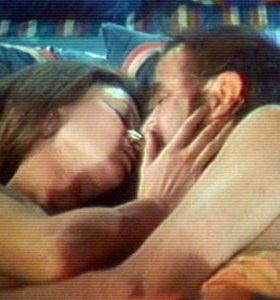
Christine and Adam (Jack played Adam, the male lead,
as well as directing the film)
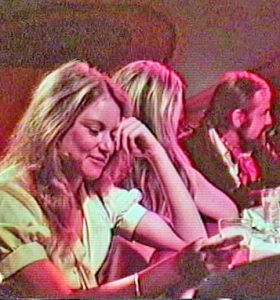
Christine and Adam
Shown in the Marketplace as Up the Girls at the Cannes Film Festival, 1975, the film was never distributed.
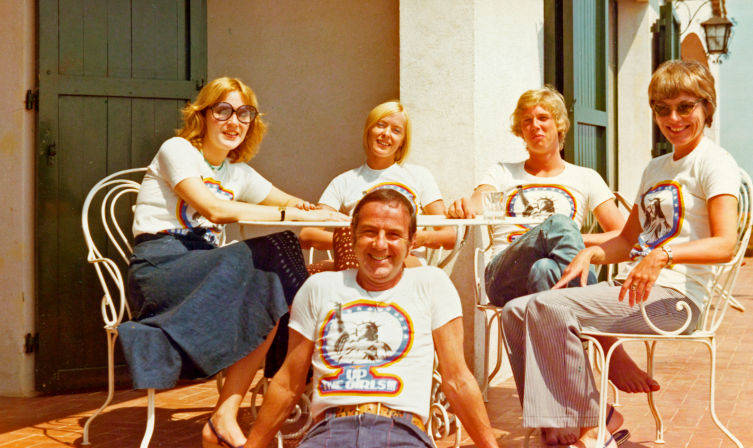
Jack and friends at the Villa they shared in Golfe Juan during the Cannes Film Festival, 1975; left to right: Mary Mendnm, one of the film’s stars, Britta Lindgren, Bob Kirk, and Kay Williams
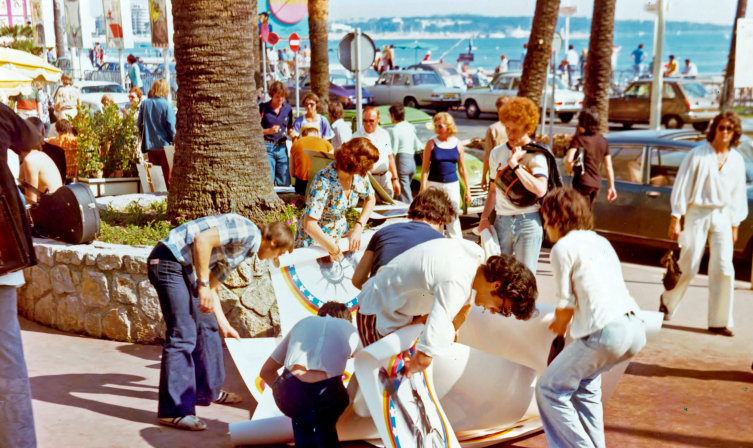
Marketing the film in Cannes, the Mediterranean in the background
JACK O’CONNELL, R.I.P.
5/2/1923 – 7/20/2019
BRITTA LINDGREN, R.I.P.
3/24/1943 – 4/28/2024
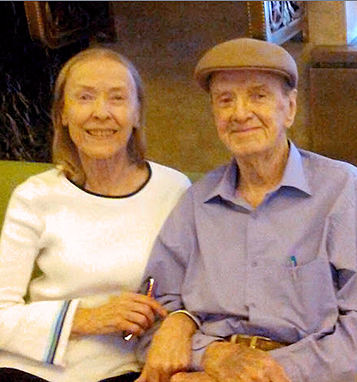
Jack, with his wife Britta, September, 2017
Jack told Britta every day, “You are my sunshine.” She was for him and he for her. Jack went gently “into that good night” at the age of 96, holding Britta’s hand.
CONTACTS
Since 2011 Britta and Kay worked to preserve the legacy of Jack O’Connell. With the professional help of Duart, they color corrected, digitized, and made DVDs of his films. The original materials found a home with Anthology Film Archives, thanks to Indie Collect.
Now Jack’s nieces, Melissa and Caroline are helping to spread the word about Jack, his life and career.
For more information about Jack, his life and career, e-mail Kay at kay@calliopepress.com and Caroline at caroline.a.oconnell@protonmail.com.
IndieCollect
IndieCollect is advocating for conservation of the entire field of independent cinema, across all genres, including fiction, non-fiction, hybrid and experimental works. Independent films represent alternative voices, innovative storytelling techniques, geographical and demographic diversity, and they tackle a vast array of topics. IndieCollect intends to make an eloquent case for how each film fits into the nation’s social and artistic fabric and why this or that archive might wish to safeguard the work. In the largest sense, IndieCollect’s mission is to ensure that when the history of motion pictures is written at the end of this century, the work of independent filmmakers will not have been eclipsed. Eventually, IndieCollect will offer digital storage and streaming for indie filmmakers who want this service.
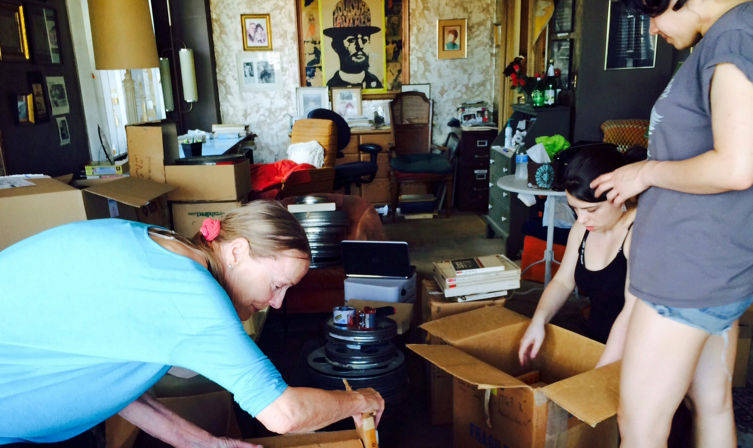
Britta helps IndieCollect catalogue and pack up Jack’s films,
Jack’s and Britta’s apartment, left to right: Britta, Pamela, and Max
